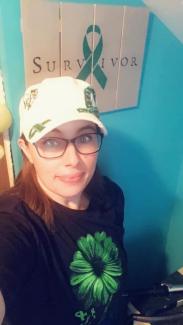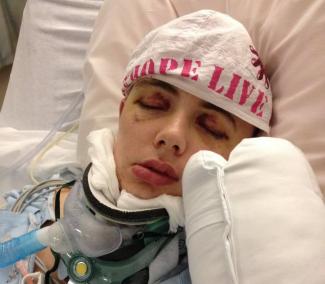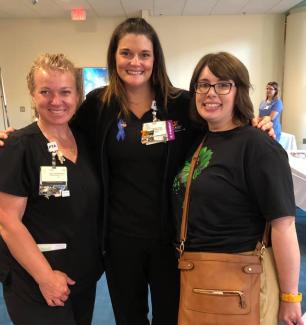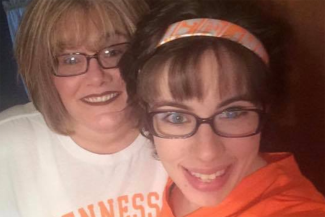
It was a gray, rainy day in Tazewell, Tennessee, in October 2014. “We waited for a break in the showers,” said Emily, 26, of Ypsilanti, Michigan. Emily, who worked as a patient care tech at Saint Joseph Mercy Health System in Ann Arbor, was vacationing with her family. “When the sky cleared, my parents, cousins and I hopped on the four-wheelers and went for a ride.”
On the way back home, Emily’s mom, KelliAnn, saw Emily swat something, probably a bee. As she did, Emily overcorrected, and the ATV flipped, landing on top of her.
A Guardian Angel
“I thought she died,” said KelliAnn. Everyone else in the party had ridden ahead. Alone with her daughter, KelliAnn yelled to get the family’s attention.
While she was waiting for them to return, something strange happened. “Out of nowhere, there came this man,” said KelliAnn. “A tall, thin man with brown hair and a beard. He said, ‘Help is on the way.’ The next thing I remember was hearing sirens, and then the rest of the family was there, helping lift the ATV off Emily.”
Though they searched for the man, they couldn’t find him. And nobody recognized his description, including KelliAnn’s uncle, who had lived in Tazewell most of his life. “I know that man was Emily’s guardian angel,” KelliAnn said.
How Emily Beat the Odds

Emily was taken first to the local hospital, then transferred by UT LIFESTAR that same day to UT Medical Center. Because of her diagnosis of traumatic brain injury, doctors gave her a 15- 20 percent chance of survival.
But Emily beat the odds. She lived through the trip and was admitted to the Trauma Surgical Intensive Care Unit, where doctors put a hollow device (or bolt) in her head to measure the pressure on her brain. Eventually, the pressure was so high that the doctors did a craniotomy, removing part of Emily’s skull to relieve the force.
The surgery worked, and Emily began to improve. Once a patient with traumatic brain injury stabilizes, the next step is to start rehab. Emily – whose doctors thought she might never walk or talk again – continued to beat the odds.
“One of the therapists said, ‘This girl is ready to walk,’” said KelliAnn. So, over the next few weeks, through focused rehabilitation, Emily slowly got back on her feet.
She went home to Michigan after almost a month at the medical center. There, she became a patient at St. Joseph’s, on the very floor where she had worked as a patient care tech.
She continued to improve and finally went home. For several months, she couldn’t be alone because of the craniotomy. “I had to wear a helmet 24/7,” Emily said. “My mom would follow me to the bathroom. I felt like I was five all over again.”
Coming Full Circle

In February 2015, doctors replaced Emily’s skull, and she was able to be more independent. Over the next couple of years, she rebuilt her life, eventually going back to work at St. Joseph’s.
Now she shares her story with other traumatic brain injury patients and families. “I feel especially called to work with young people,” she said. “I tell them, ‘I was in your position. I know what you’re going through.’”
A Story That Doesn’t End
The family’s life changed forever that day, but that includes changes for the better. “The love and support we got from UT Medical Center got us through,” said Emily. “We’ve made lifelong friends there.”
“We wouldn’t have gotten through without the kindness and expertise of people at UT Medical Center,” said KelliAnn. “They mean so much to us. We go back for Trauma Survivors Network events, or when we’re in town visiting family. It’s a story that doesn’t end.”
Follow Emily’s story on Facebook at Fight with Emily
